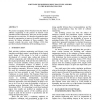328 search results - page 7 / 66 » Presenting crosscutting structure with active models |
PERCOM
2003
ACM
14 years 22 days ago
2003
ACM
Seeking to extend the functional capability of the elderly, we explore the use of probabilistic methods to learn and recognise human activity in order to provide monitoring suppor...
WSC
1993
13 years 8 months ago
1993
We present a mapping of Best Practices from the field of software engineering to the practice of discrete event simulation model construction. There are obvious parallels between ...
WWW
2004
ACM
14 years 8 months ago
2004
ACM
The ability to determine what day-to-day activity (such as cooking pasta, taking a pill, or watching a video) a person is performing is of interest in many application domains. A ...
ECOOP
2006
Springer
13 years 11 months ago
2006
Springer
Aspect-Oriented Programming (AOP) is a powerful technique to better modularize object-oriented programs by introducing crosscutting concerns in a safe and noninvasive way. Unfortu...
CASSIS
2005
Springer
14 years 1 months ago
2005
Springer
System software for deeply embedded devices has to cope with a broad variety of requirements and platforms, but especially with strict resource constraints. To compete against prop...

